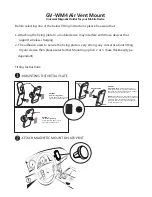
SAFETY GUIDLINES
General safety
Attention should be paid to all safety instructions in this manual. Keep the manual located close to the battery for
future reference. Maintenance or repair work should only be carried out by qualified personnel. A damaged or abnormal
functioning battery should not be used. Keep the battery away from children. The battery should be used for general
purpose, small drive trains and source for static electrical equipment. The batteries should not be used for critical
equipment like medical equipment unless a thorough risk analysis has been conducted.
Explosion and fire
>
The battery terminals have a different polarity. For this reason, you should not place any conductive materials on the
battery. When working close to the battery it is advised not to ware any jewelry or watches to prevent short circuits.
>
The battery should not come in contact with fire or be placed close to a heat source.
>
Use and store the battery on a non-flammable, heat resistance and non-conductive surface.
>
Contact with very humid air and water should be avoided as much as possible. Store the battery on a dry and safe place.
>
Use a type D, foam or CO2 type fire extinguisher in case of fire.
Safety and protection
>
Never try to open the battery or dismantle the battery. De battery contains electrolyte. Under normal operational
conditions contact with the electrolyte is impossible. If the battery casing is damaged do not touch the electrolyte or
other materials released from the battery. In case of contact with the electrolyte: rinse thoroughly with water and consult
a doctor.
>
Prevent damaging of the battery, a damaged battery should not be used anymore.
>
A damaged battery has to be disposed according local guidelines as small chemical waste.
>
Prevent mechanical shock and extreme vibrations as the batteries can get damaged. Never cut or drill in the casing.
>
Prevent contact with the connections of the battery.
>
Use only special LiFePO4 chargers or standard chargers programmed to be used within the specifications of the batteries.
Guidance for connecting battery packs
>
Use connection wires of sufficient diameter. Take maximum current and length of the cable into account when
selecting the connection cables.
>
Putting batteries in series is only allowed for 12V batteries and up to a maximum of three of the same type (36V). Make
sure that the batteries are fully charged separately before they are connected.
>
Up to 8 batteries can be placed in parallel to increase the capacity. For safety reasons however it’s recommended to
limit the current to two times the maximum current of one battery or to fuse every battery separately by a fuse of two
times the maximum continuous current of one battery.
Charging and discharging
>
Check the mains on the right voltage at the moment you connect your battery charger.
>
The battery should only been charged with the cables supplied with the battery charger. Extending the charger cables
can cause slow or not completely charging of your battery.
>
The battery should not be charged with damaged cables. Check before charging the batteries.
4


























